Coriander
Coriander (/ˌkɒriˈændər, ˈkɒriændər/;[1] Coriandrum sativum) is an annual herb in the family Apiaceae. It is also known as Chinese parsley, and in the United States the stems and leaves are usually called cilantro (/sɪˈlæntroʊ, -ˈlɑːn-/).[2] All parts of the plant are edible, but the fresh leaves and the dried seeds (as a spice) are the parts most traditionally used in cooking.
| Coriander or cilantro | |
|---|---|
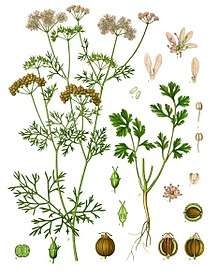 | |
| Illustration of coriander parts | |
| Scientific classification | |
| Kingdom: | Plantae |
| Clade: | Tracheophytes |
| Clade: | Angiosperms |
| Clade: | Eudicots |
| Clade: | Asterids |
| Order: | Apiales |
| Family: | Apiaceae |
| Genus: | Coriandrum |
| Species: | C. sativum |
| Binomial name | |
| Coriandrum sativum | |
Most people perceive the taste of coriander leaves as a tart, lemon/lime taste, but a smaller group of about 3–21% of people tested think the leaves taste like dish soap, linked to a gene which detects some specific aldehydes that are also used as odorant substances in many soaps and detergents.[3]
Botanical description
Coriander is native to regions spanning from Southern Europe and Northern Africa to Southwestern Asia. It is a soft plant growing to 50 cm (20 in) tall. The leaves are variable in shape, broadly lobed at the base of the plant, and slender and feathery higher on the flowering stems. The flowers are borne in small umbels, white or very pale pink, asymmetrical, with the petals pointing away from the center of the umbel longer (5–6 mm or 0.20–0.24 in) than those pointing toward it (only 1–3 mm or 0.039–0.118 in long). The fruit is a globular, dry schizocarp 3–5 mm (0.12–0.20 in) in diameter. Pollen size is approximately 33 microns.

Etymology
First attested in English in the late 14th century, the word "coriander" derives from the Old French coriandre, which comes from Latin coriandrum,[4] in turn from Ancient Greek κορίαννον koriannon (or κορίανδρον koriandron),[5][6] possibly derived from or related to κόρις kóris (a bed bug),[7][8] and was given on account of its foetid, bed bug-like smell.[9] The earliest attested form of the word is the Mycenaean Greek 𐀒𐀪𐀊𐀅𐀙 ko-ri-ja-da-na[10] (variants: 𐀒𐀪𐁀𐀅𐀙 ko-ri-a2-da-na, 𐀒𐀪𐀊𐀈𐀜 ko-ri-ja-do-no, 𐀒𐀪𐀍𐀅𐀙 ko-ri-jo-da-na)[11] written in Linear B syllabic script (reconstructed as koriadnon, similar to the name of Minos's daughter Ariadne) which later evolved to koriannon or koriandron,[12] and koriander (German).[13]
Cilantro is the Spanish word for coriander, also deriving from coriandrum. It is the common term in American English for coriander leaves, due to their extensive use in Mexican cuisine.[13] Both cilantro and coriander are understood in Canada though the seeds are always called coriander.
Origin
Although native to Iran,[14] coriander grows wild over a wide area of Western Asia and Southern Europe, prompting the comment: "It is hard to define exactly where this plant is wild and where it only recently established itself."[15] Fifteen desiccated mericarps were found in the Pre-Pottery Neolithic B level of the Nahal Hemar Cave in Israel, which may be the oldest archaeological find of coriander. About half a litre of coriander mericarps was recovered from the tomb of Tutankhamen, and because this plant does not grow wild in Egypt, Zohary and Hopf interpret this find as proof that coriander was cultivated by the ancient Egyptians.[15]
Coriander seems to have been cultivated in Greece since at least the second millennium BC. One of the Linear B tablets recovered from Pylos refers to the species as being cultivated for the manufacture of perfumes; it apparently was used in two forms: as a spice for its seeds and as a herb for the flavour of its leaves.[12] This appears to be confirmed by archaeological evidence from the same period; the large quantities of the species retrieved from an Early Bronze Age layer at Sitagroi in Macedonia could point to cultivation of the species at that time.[16]
Uses
All parts of the plant are edible, but the fresh leaves and the dried seeds are the parts most traditionally used in cooking, Coriander is used in cuisines throughout the world.[17]
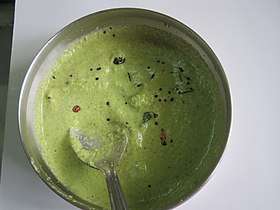 Coriander leaves in coconut chutney
Coriander leaves in coconut chutney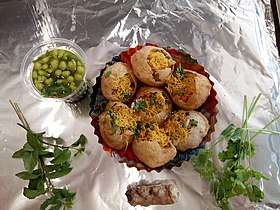 Minty pani puri
Minty pani puri- Onion coriander paratha
Leaves
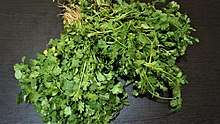
The leaves are variously referred to as coriander leaves, fresh coriander, dhania, Chinese parsley, or (in the US and commercially in Canada) cilantro.
Coriander potentially may be confused with culantro (Eryngium foetidum L.), an Apiaceae like coriander (Coriandrum sativum L.), but from a different genus. Culantro has a distinctly different spiny appearance, a more potent volatile leaf oil[18] and a stronger aroma.
The leaves have a different taste from the seeds, with citrus overtones.[19]
The fresh leaves are an ingredient in many foods, such as chutneys and salads, salsa, guacamole, and as a widely-used garnish for soup, fish and meat.[20] As heat diminishes their flavour, coriander leaves are often used raw or added to the dish immediately before serving. In Indian and Central Asian recipes, coriander leaves are used in large amounts and cooked until the flavour diminishes.[13] The leaves spoil quickly when removed from the plant, and lose their aroma when dried or frozen.
Seeds
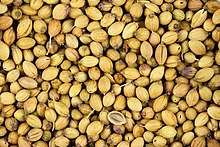
The dry fruits are known as coriander seeds. The word "coriander" in food preparation may refer solely to these seeds (as a spice), rather than to the plant. The seeds have a lemony citrus flavour when crushed, due to terpenes linalool and pinene. It is described as warm, nutty, spicy, and orange-flavoured.
The variety C. s. vulgare has a fruit diameter of 3–5 mm (0.12–0.20 in), while var. C. s. microcarpum fruits have a diameter of 1.5–3 mm (0.06–0.12 in). Large-fruited types are grown mainly by tropical and subtropical countries, e.g. Morocco, India, and Australia, and contain a low volatile oil content (0.1-0.4%). They are used extensively for grinding and blending purposes in the spice trade. Types with smaller fruit are produced in temperate regions and usually have a volatile oil content around 0.4-1.8%, so are highly valued as a raw material for the preparation of essential oil.[21]
Coriander is commonly found both as whole dried seeds and in ground form. Roasting or heating the seeds in a dry pan heightens the flavour, aroma, and pungency. Ground coriander seed loses flavour quickly in storage and is best ground fresh. Coriander seed is a spice in garam masala and Indian curries which often employ the ground fruits in generous amounts together with cumin, acting as a thickener in a mixture called dhana jeera.[22] Roasted coriander seeds, called dhana dal, are eaten as a snack. They are the main ingredient of the two south Indian dishes sambhar and rasam.
Outside of Asia, coriander seed is used widely in the process for pickling vegetables. In Germany and South Africa (see boerewors), the seeds are used while making sausages. In Russia and Central Europe, coriander seed is an occasional ingredient in rye bread (e.g. Borodinsky bread), as an alternative to caraway. The Zuni people of North America have adapted it into their cuisine, mixing the powdered seeds ground with chili and using it as a condiment with meat, and eating leaves as a salad.[23]
Coriander seeds are used in brewing certain styles of beer, particularly some Belgian wheat beers. The coriander seeds are used with orange peel to add a citrus character. Coriander seed is one of the main traditional ingredients in the South African Boerewors, a spiced mixed-meat sausage.
One preliminary study showed coriander essential oil to inhibit Gram-positive and Gram-negative bacteria, including Staphylococcus aureus, Enterococcus faecalis, Pseudomonas aeruginosa, and Escherichia coli.[24]
Coriander is listed as one of the original ingredients in the secret formula for Coca-Cola.[25]
Roots
Coriander roots have a deeper, more intense flavor than the leaves, and are used in a variety of Asian cuisines, especially in Thai dishes such as soups or curry pastes.
Nutrition
| Nutritional value per 100 g (3.5 oz) | |
|---|---|
| Energy | 95 kJ (23 kcal) |
3.67 g | |
| Sugars | 0.87 |
| Dietary fiber | 2.8 g |
0.52 g | |
2.13 g | |
| Vitamins | Quantity %DV† |
| Vitamin A equiv. lutein zeaxanthin | 42% 337 μg36% 3930 μg865 μg |
| Thiamine (B1) | 6% 0.067 mg |
| Riboflavin (B2) | 14% 0.162 mg |
| Niacin (B3) | 7% 1.114 mg |
| Pantothenic acid (B5) | 11% 0.57 mg |
| Vitamin B6 | 11% 0.149 mg |
| Folate (B9) | 16% 62 μg |
| Vitamin C | 33% 27 mg |
| Vitamin E | 17% 2.5 mg |
| Vitamin K | 295% 310 μg |
| Minerals | Quantity %DV† |
| Calcium | 7% 67 mg |
| Iron | 14% 1.77 mg |
| Magnesium | 7% 26 mg |
| Manganese | 20% 0.426 mg |
| Phosphorus | 7% 48 mg |
| Potassium | 11% 521 mg |
| Sodium | 3% 46 mg |
| Zinc | 5% 0.5 mg |
| Other constituents | Quantity |
| Water | 92.21 g |
| |
| †Percentages are roughly approximated using US recommendations for adults. Source: USDA Nutrient Database | |
Raw coriander leaves are 92% water, 4% carbohydrates, 2% protein, and less than 1% fat (table). The nutritional profile of coriander seeds is different from the fresh stems or leaves. In a 100 gram reference amount, leaves are particularly rich in vitamin A, vitamin C and vitamin K, with moderate content of dietary minerals (table). Although seeds generally have lower content of vitamins, they do provide significant amounts of dietary fiber, calcium, selenium, iron, magnesium and manganese.[26]
Taste and smell
The essential oil from coriander leaves and seeds contains mixed polyphenols and terpenes, including linalool as the major constituent accounting for the aroma and flavor of coriander.[27]
Different people may perceive the taste of coriander leaves differently. Those who enjoy it say it has a refreshing, lemony or lime-like flavor, while those who dislike it have a strong aversion to its taste and smell, characterizing it as soapy or rotten.[19][28] Studies also show variations in preference among different ethnic groups: 21% of East Asians, 17% of Caucasians, and 14% of people of African descent expressed a dislike for coriander, but among the groups where coriander is popular in their cuisine, only 7% of South Asians, 4% of Hispanics, and 3% of Middle Eastern subjects expressed a dislike.[29]
Studies have shown that 80% of identical twins shared the same preference for the herb, but fraternal twins agreed only about half the time, strongly suggesting a genetic component to the preference. In a genetic survey of nearly 30,000 people, two genetic variants linked to perception of coriander have been found, the most common of which is a gene involved in sensing smells.[30] The gene, OR6A2, lies within a cluster of olfactory-receptor genes, and encodes a receptor that is highly sensitive to aldehyde chemicals. Flavor chemists have found that the coriander aroma is created by a half-dozen or so substances, and most of these are aldehydes. Those who dislike the taste are sensitive to the offending unsaturated aldehydes and at the same time may be unable to detect the aromatic chemicals that others find pleasant.[31] Association between its taste and several other genes, including a bitter-taste receptor, have also been found.[3][32]
Allergy
Some people are allergic to coriander leaves or seeds, having symptoms similar to those of other food allergies.[33] In one study, 32% of pin-prick tests in children and 23% in adults were positive for coriander and other members of the family Apiaceae, including caraway, fennel, and celery.[33] The allergic symptoms may be minor or life-threatening.[34][35]
Similar plants
Other herbs are used where they grow in much the same way as coriander leaves.
- Eryngium foetidum has a similar, but more intense, taste. Known as culantro, it is found in Mexico, South America, and the Caribbean.[36]
- Persicaria odorata is commonly called Vietnamese coriander, or rau răm. The leaves have a similar odour and flavour to coriander. It is a member of the Polygonaceae, or buckwheat family.[36]
- Papaloquelite is one common name for Porophyllum ruderale subsp. macrocephalum, a member of the Asteraceae, the sunflower family. This species is found growing wild from Texas to Argentina.[36]
References
- coriander in the Cambridge English Pronouncing Dictionary
- cilantro in the Cambridge English Pronouncing Dictionary
- Callaway, Ewen (12 September 2012). "Soapy taste of coriander linked to genetic variants". Nature. doi:10.1038/nature.2012.11398. Retrieved 20 July 2019.
- coriandrum. Charlton T. Lewis and Charles Short. A Latin Dictionary on Perseus Project.
- κορίαννον. Liddell, Henry George; Scott, Robert; A Greek–English Lexicon at the Perseus Project.
- "Coriander", Oxford English Dictionary 2nd ed., 1989. Oxford University Press.
- κόρις in Liddell and Scott.
- Harper, Douglas. "coriander". Online Etymology Dictionary.
- Chisholm, Hugh, ed. (1911). . Encyclopædia Britannica. 7 (11th ed.). Cambridge University Press. p. 146.
- "The Linear B word ko-ri-ja-da-na". Palaeolexicon.
- Arnott, Robert (2014). "Healers and Medicines in the Mycenaean Greek Texts". In Michaelides, Demetrios (ed.). Medicine and Healing in the Ancient Mediterranean. Oxbow Books. p. 48. ISBN 978-1-78297-235-8.
- Chadwick, John (1976). The Mycenaean World. Cambridge University Press. p. 119.
- "Coriander (Coriandrum sativum)". Gernot Katzer Spice Pages. 29 February 2012. Retrieved 1 July 2018.
- Batmanglij, Najmieh (2 March 2018). A Taste of Persia: An Introduction to Persian Cooking. I.B.Tauris. ISBN 9781845114374. Retrieved 2 March 2018 – via Google Books.
- Zohary, Daniel; Hopf, Maria (2000). Domestication of Plants in the Old World (Third ed.). Oxford: Oxford University Press. pp. 205–206. ISBN 0-19-850357-1.
- Fragiska, M. (2005). "Wild and Cultivated Vegetables, Herbs and Spices in Greek Antiquity". Environmental Archaeology. 10 (1): 73–82. doi:10.1179/146141005790083858.
- Samuelsson, Marcus (2003). Aquavit: And the New Scandinavian Cuisine. Houghton Mifflin Harcourt. p. 12 (of 312). ISBN 978-0-618-10941-8.
- Ramcharan, C. (1999). J. Janick (ed.). "Perspectives on new crops and new uses – Chapter: Culantro: A much utilized, little understood herb". ASHS Press: 506–509. Cite journal requires
|journal=(help) - McGee, Harold (13 April 2010). "Cilantro Haters, It's Not Your Fault". The New York Times. Retrieved 24 July 2012.
Some people may be genetically predisposed to dislike cilantro, according to often-cited studies by Charles J. Wysocki of the Monell Chemical Senses Center in Philadelphia.
- Moulin, Léo (2002). Eating and Drinking in Europe: A Cultural History. Mercatorfonds. p. 168. ISBN 978-9061535287.
- Bruce Smallfield (June 1993). "Coriander – Coriandrum sativum". Archived from the original on 4 April 2004.
- "Dhana Jeera Powder – Also Known As Cumin and Coriander Blend or Dhanajiru Powder". My Spice Sage. Retrieved 14 January 2016.
- Stevenson, Matilda Coxe 1915 Ethnobotany of the Zuni Indians. SI-BAE Annual Report #30 (p. 66)
- Silva, Filomena; Ferreira, Susana; Queiroz, Joao A; Domingues, Fernanda C (2011). "Coriander (Coriandrum sativum L.) essential oil: its antibacterial activity and mode of action evaluated by flow cytometry". Journal of Medical Microbiology. 60 (Pt 10): 1479–86. doi:10.1099/jmm.0.034157-0. PMID 21862758.
- Pendergrast, Mark (1994). For God, Country and Coca-Cola. Collier. p. 422.
- "Nutritional Data, coriander seed, per 100 g". nutritiondata.self.com. Conde Nast. Retrieved 10 August 2013.
- Zheljazkov, V. D; Astatkie, T; Schlegel, V (2014). "Hydrodistillation extraction time effect on essential oil yield, composition, and bioactivity of coriander oil". Journal of Oleo Science. 63 (9): 857–65. doi:10.5650/jos.ess14014. PMID 25132088.
- Rubenstein, Sarah (13 February 2009). "Across the Land, People Are Fuming Over an Herb (No, Not That One)". The Wall Street Journal. Retrieved 24 July 2012.
- Lilli Mauer and Ahmed El-Sohemy (2 May 2012). "Prevalence of cilantro (Coriandrum sativum) disliking among different ethnocultural groups". Flavour. 1 (8): 8. doi:10.1186/2044-7248-1-8.CS1 maint: uses authors parameter (link)
- Francke, Uta; Hinds, David A.; Mountain, Joanna L.; Tung, Joyce Y.; Kiefer, Amy K.; Do, Chuong B.; Wu, Shirley; Eriksson, Nicholas (10 September 2012). "A genetic variant near olfactory receptor genes influences cilantro preference". arXiv:1209.2096. Cite journal requires
|journal=(help) - Josh Kurz (26 December 2008). "Getting To The Root Of The Great Cilantro Divide". NPR.
- Knaapila A1, Hwang LD, Lysenko A, Duke FF, Fesi B, Khoshnevisan A, James RS, Wysocki CJ, Rhyu M, Tordoff MG, Bachmanov AA, Mura E, Nagai H, Reed DR (2012). "Genetic analysis of chemosensory traits in human twins". Chemical Senses. 37 (9): 869–81. doi:10.1093/chemse/bjs070. PMC 3589946. PMID 22977065.CS1 maint: multiple names: authors list (link)
- Moneret-Vautrin, D. A; Morisset, M; Lemerdy, P; Croizier, A; Kanny, G (2002). "Food allergy and IgE sensitization caused by spices: CICBAA data (based on 589 cases of food allergy)". Allergie et Immunologie. 34 (4): 135–40. PMID 12078423.
- Kathleen Pointer (29 March 2017). "How to Recognize a Cilantro Allergy". Healthline. Retrieved 17 March 2018.
- Christina Agapakis (18 September 2011). "Allergy Recapitulates Phylogeny". Scientific American. Retrieved 17 March 2018.
- Tucker, A.O.; DeBaggio, T. (1992). "Cilantro Around The World". Herb Companion. 4 (4): 36–41.
External links
